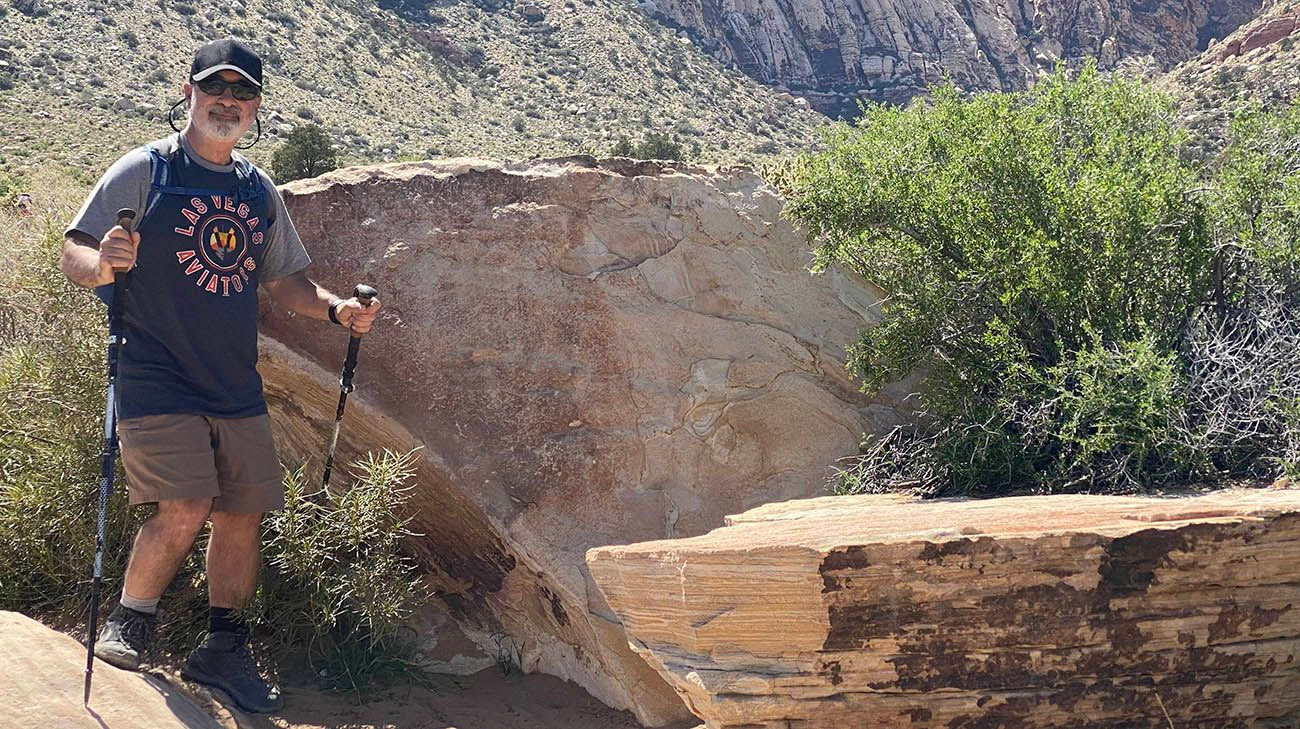
While reaching the summit of one of his favorite desert hikes, surrounded by red rocks, Raul Hernandez is reminded why he moved to the Southwest.
Raul and his family relocated to Nevada in 2020 from North Carolina because of their passion for the outdoors. He was used to hiking up to 10 miles at a time, at least once a week. However, shortly after the move, “it became very difficult for me to do the things I love. I was in a lot of pain,” says Raul. “Even daily tasks became a challenge.”
For nearly 30 years, the retired electrical engineer has lived with multiple sclerosis (MS), an immune disease of the brain and spinal cord that affects how neurons communicate with each other. While symptoms of the disease, including pain, muscle weakness and numbness, can vary in type and severity from person to person, for decades Raul had managed his symptoms through medication, exercise and a healthy diet.
So, when he started experiencing fatigue and debilitating pain in his torso, he went looking for a doctor near his new home in Nevada. He was told the pain likely stemmed from MS and nothing could be done.
Unwilling to accept what might be a new reality, he went for a second opinion with Carrie M. Hersh, DO, a neurologist who specializes in MS and neuroimmunology at Cleveland Clinic Lou Ruvo Center for Brain Health in Las Vegas.
Dr. Hersh was able to identify a most unexpected cause: Raul is living with not one, but two autoimmune conditions — MS, which affects the central nervous system, and inflammatory polyradiculitis, which impacts peripheral nerves, essentially the rest of the nervous system.

Raul enjoys a hike near Las Vegas after building back his endurance (courtesy Raul Hernandez).
Nearly 1 million people are living with MS in the U.S. It is estimated between 5 and 45% of them have reported issues with peripheral nerves, but the true number may be underreported.
Moreover, inflammatory polyradiculitis is a difficult diagnosis to make in an individual living with multiple sclerosis, because the symptoms may mimic each other. Several tests and clinical monitoring are necessary to differentiate between the two. With the rate of misdiagnosis in MS alone at 10-30%, making yet a second correct diagnosis is even more unlikely.
“I am so thankful for Dr. Hersh. Instead of jumping to conclusions that my MS was declining, she took the time to consider even the most unlikely possibilities,” says Raul. “While others had overlooked inflammatory polyradiculitis, she was committed to finding an answer, no matter how obscure.”
“Having expertise in MS and related neuroimmunological disorders, we know what to listen and watch for. After years of stable MS, having new symptoms is something that requires us to investigate further,” says Dr. Hersh. “In this case, we completed a new MRI and took a detailed look at his nerves.”
With the cause of his symptoms identified, Raul started a new medication that targets both MS and inflammatory polyradiculitis. Dr. Hersh, a proponent of person-centric care, emphasized the importance of emotional as well as physical outcomes. She referred Raul to the behavioral medicine and sleep management teams to optimize rest and fatigue management and prepare him for physical activity.
He worked with a physical therapist to help regain his strength and balance. With his passion for the outdoors in mind, his therapy team put together obstacle courses to simulate what he would experience on a rocky hike. Within a few months, he was back on the trails.
“It's like night and day. I feel so much better and I’m able to do more and more,” says Raul.

Raul takes in the scenery of a red rock hike (courtesy Raul Hernandez).
Having regained strength and confidence on familiar trails, Raul is planning to tackle new paths at Yellowstone and Grand Teton National Parks.
“When we diagnose accurately and early, we can get people on the right treatment to improve their outcomes and overall wellbeing. In Raul’s case, it was about recognizing when a drug therapy is no longer working and making a switch quickly to lower the risk of disability,” says Dr. Hersh. “My heart just sings when I see people like Raul managing a chronic condition and enjoying what’s most fulfilling for them. He’s hiking – and able to do it safely. It’s joyous!”
For Raul, a second opinion meant a second diagnosis, but also a second chance to get his immune system in check and return to hiking. While he moved to Nevada to enjoy outdoor adventures, he says, “Perhaps the most unexpected blessing was finding Cleveland Clinic here, in the desert.”
Related Institutes: Neurological Institute

